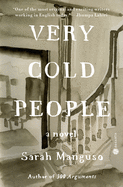
"Snowfalls have unique bouquets," Sarah Manguso writes in her first novel, Very Cold People. "Snow isn't just frozen water; it carries a remnant of the sky." Manguso's book hosts impressions so immediate that readers may half wonder if the childhood depicted on the page is theirs.
Ruth, who narrates Very Cold People, grew up an only child in the 1980s in the (fictional) colonial town of Waitsfield, Mass., whose "historically correct" paint colors are considerably more subdued than its class distinctions. Ruth, a devotee of "playing at belonging," takes readers through the childhood events that have marked her--fleeting occasions like a trip to a fancy restaurant in Boston with family, and major developments like her move at age 13 to a new Waitsfield home (historically significant house, better school zone).
Manguso, whose previous books are works of poetry and nonfiction (Ongoingness; 300 Arguments), is a sensational writer (her school auditorium "was like the inside of a slaughtered animal, all oxblood paint and maroon velveteen"). But with a hundred-odd pages behind them, readers may well wonder: Is Very Cold People truly a novel, as advertised? Manguso certainly massages her themes (social and familial alienation, predatory men who are trusted members of the community), but as vignette-like paragraphs skip by, each bluntly delineated from the next by a page break, there seems to be no forward momentum beyond the ticking of time.
Readers should hang in there. Manguso's accreting vignettes retroactively assume a shape toward the end of Very Cold People, when something happens that fulfills every novel's basic requirement: life for at least one character in it irrevocably changes. --Nell Beram, author and freelance writer

